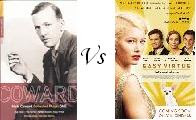 It occurs to me that I haven't done a movie review in quite some time, so I thought I'd compare the latest three blockbusters I've seen at the cinemas.
It occurs to me that I haven't done a movie review in quite some time, so I thought I'd compare the latest three blockbusters I've seen at the cinemas.First off, Wolverine. I was already prepared to like it because, let's face it, it's Hugh Jackman in tight leather with those awesome claws - what's not to like? And like it I did. It hit all the right notes with the right amount of action, drama, tension and hero shots of Jackman, as well as sibling rivalry and tragic romance thrown in. The storyline was only a tad formulaic.
Then along came Star Trek, and totally blew Wolverine into outer space (hence the sketchy review - I can barely remember any movie before Star Trek now). I'm not a trekkie and I'm not even a big sci-fi fan, but this movie had me at hello and didn't let me go until the final credits rolled. It's a great big ball of fun that somehow keeps the corniness at just the right level so you can enjoy the humour and melodrama without rolling your eyes - not many American blockbusters do that this well. Similar to Wolverine, Star Trek is an origin-story that tells how a snotty-brilliant-rebellious youth becomes the famous Captain Kirk, with a parallel story of how Spock becomes Spock - actually, Spock was always the very steady Spock so it's not a huge Spock-revelation, just a chance to enjoy Sylar's performance.
Then on one bored evening, I accompanied some friends to see Angels and Demons. I think the low expectations helped. It didn't totally suck, but with this much choice in the cinemas, why bother.
So there you have it: Star Trek is a must, Wolverine is a good waste of 2.5 hours, and Angels and Demons only if you're a Dan Brown or Tom Hanks fan. Or Ewan MacGregor, although there's not much to perve at since he's always in the priestly robe-thing.
On a side note, I have to mention how good it is to see broader ethnicity in these blockbusters. Black people have really stepped up into lead roles in the past decade (thank Denzel Washington), but Wolverine also has a half-Korean Agent Zero (whose hotness rating, according to some, is anything but zero) and Star Trek is full of them - African-American, Asian, Russian, Scottish, and even green people - it's off the planet! Literally! It's great to see so keep it going, Hollywood (yes I know you keep your eye on my blog with breathless anticipation).






